Video Denoising
Video denoising is the process of removing noise from video sequences to improve their quality.
Papers and Code
X-Diffusion: Training Diffusion Policies on Cross-Embodiment Human Demonstrations
Nov 06, 2025Human videos can be recorded quickly and at scale, making them an appealing source of training data for robot learning. However, humans and robots differ fundamentally in embodiment, resulting in mismatched action execution. Direct kinematic retargeting of human hand motion can therefore produce actions that are physically infeasible for robots. Despite these low-level differences, human demonstrations provide valuable motion cues about how to manipulate and interact with objects. Our key idea is to exploit the forward diffusion process: as noise is added to actions, low-level execution differences fade while high-level task guidance is preserved. We present X-Diffusion, a principled framework for training diffusion policies that maximally leverages human data without learning dynamically infeasible motions. X-Diffusion first trains a classifier to predict whether a noisy action is executed by a human or robot. Then, a human action is incorporated into policy training only after adding sufficient noise such that the classifier cannot discern its embodiment. Actions consistent with robot execution supervise fine-grained denoising at low noise levels, while mismatched human actions provide only coarse guidance at higher noise levels. Our experiments show that naive co-training under execution mismatches degrades policy performance, while X-Diffusion consistently improves it. Across five manipulation tasks, X-Diffusion achieves a 16% higher average success rate than the best baseline. The project website is available at https://portal-cornell.github.io/X-Diffusion/.
SEE4D: Pose-Free 4D Generation via Auto-Regressive Video Inpainting
Oct 30, 2025Immersive applications call for synthesizing spatiotemporal 4D content from casual videos without costly 3D supervision. Existing video-to-4D methods typically rely on manually annotated camera poses, which are labor-intensive and brittle for in-the-wild footage. Recent warp-then-inpaint approaches mitigate the need for pose labels by warping input frames along a novel camera trajectory and using an inpainting model to fill missing regions, thereby depicting the 4D scene from diverse viewpoints. However, this trajectory-to-trajectory formulation often entangles camera motion with scene dynamics and complicates both modeling and inference. We introduce SEE4D, a pose-free, trajectory-to-camera framework that replaces explicit trajectory prediction with rendering to a bank of fixed virtual cameras, thereby separating camera control from scene modeling. A view-conditional video inpainting model is trained to learn a robust geometry prior by denoising realistically synthesized warped images and to inpaint occluded or missing regions across virtual viewpoints, eliminating the need for explicit 3D annotations. Building on this inpainting core, we design a spatiotemporal autoregressive inference pipeline that traverses virtual-camera splines and extends videos with overlapping windows, enabling coherent generation at bounded per-step complexity. We validate See4D on cross-view video generation and sparse reconstruction benchmarks. Across quantitative metrics and qualitative assessments, our method achieves superior generalization and improved performance relative to pose- or trajectory-conditioned baselines, advancing practical 4D world modeling from casual videos.
BachVid: Training-Free Video Generation with Consistent Background and Character
Oct 24, 2025Diffusion Transformers (DiTs) have recently driven significant progress in text-to-video (T2V) generation. However, generating multiple videos with consistent characters and backgrounds remains a significant challenge. Existing methods typically rely on reference images or extensive training, and often only address character consistency, leaving background consistency to image-to-video models. We introduce BachVid, the first training-free method that achieves consistent video generation without needing any reference images. Our approach is based on a systematic analysis of DiT's attention mechanism and intermediate features, revealing its ability to extract foreground masks and identify matching points during the denoising process. Our method leverages this finding by first generating an identity video and caching the intermediate variables, and then inject these cached variables into corresponding positions in newly generated videos, ensuring both foreground and background consistency across multiple videos. Experimental results demonstrate that BachVid achieves robust consistency in generated videos without requiring additional training, offering a novel and efficient solution for consistent video generation without relying on reference images or additional training.
CoMo: Compositional Motion Customization for Text-to-Video Generation
Oct 27, 2025While recent text-to-video models excel at generating diverse scenes, they struggle with precise motion control, particularly for complex, multi-subject motions. Although methods for single-motion customization have been developed to address this gap, they fail in compositional scenarios due to two primary challenges: motion-appearance entanglement and ineffective multi-motion blending. This paper introduces CoMo, a novel framework for $\textbf{compositional motion customization}$ in text-to-video generation, enabling the synthesis of multiple, distinct motions within a single video. CoMo addresses these issues through a two-phase approach. First, in the single-motion learning phase, a static-dynamic decoupled tuning paradigm disentangles motion from appearance to learn a motion-specific module. Second, in the multi-motion composition phase, a plug-and-play divide-and-merge strategy composes these learned motions without additional training by spatially isolating their influence during the denoising process. To facilitate research in this new domain, we also introduce a new benchmark and a novel evaluation metric designed to assess multi-motion fidelity and blending. Extensive experiments demonstrate that CoMo achieves state-of-the-art performance, significantly advancing the capabilities of controllable video generation. Our project page is at https://como6.github.io/.
Big Data Approaches to Bovine Bioacoustics: A FAIR-Compliant Dataset and Scalable ML Framework for Precision Livestock Welfare
Oct 16, 2025

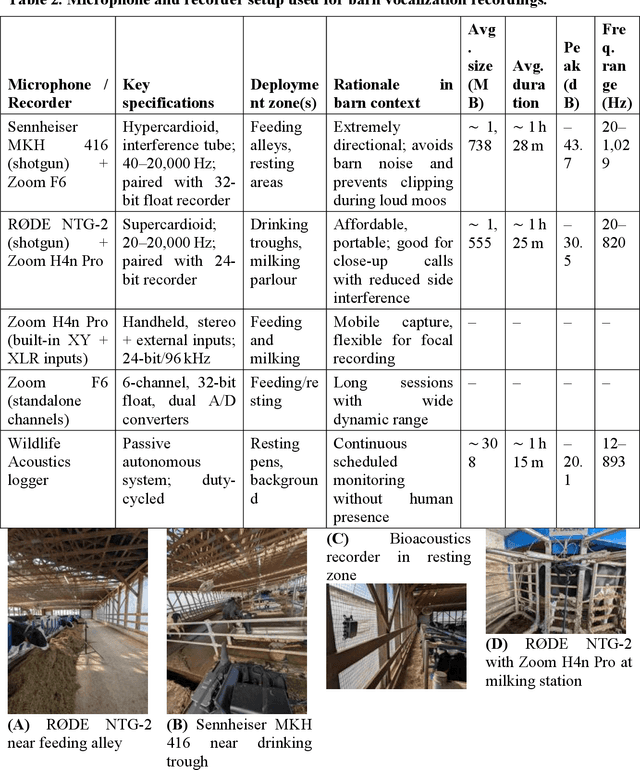
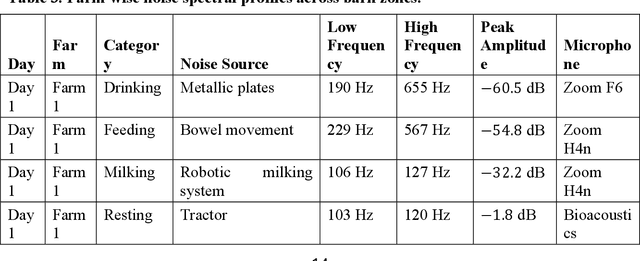
The convergence of IoT sensing, edge computing, and machine learning is transforming precision livestock farming. Yet bioacoustic data streams remain underused because of computational complexity and ecological validity challenges. We present one of the most comprehensive bovine vocalization datasets to date, with 569 curated clips covering 48 behavioral classes, recorded across three commercial dairy farms using multiple microphone arrays and expanded to 2900 samples through domain informed augmentation. This FAIR compliant resource addresses major Big Data challenges - volume (90 hours of recordings, 65.6 GB), variety (multi farm and multi zone acoustics), velocity (real time processing), and veracity (noise robust feature extraction). Our distributed processing framework integrates advanced denoising using iZotope RX, multimodal synchronization through audio and video alignment, and standardized feature engineering with 24 acoustic descriptors generated from Praat, librosa, and openSMILE. Preliminary benchmarks reveal distinct class level acoustic patterns for estrus detection, distress classification, and maternal communication. The datasets ecological realism, reflecting authentic barn acoustics rather than controlled settings, ensures readiness for field deployment. This work establishes a foundation for animal centered AI, where bioacoustic data enable continuous and non invasive welfare assessment at industrial scale. By releasing standardized pipelines and detailed metadata, we promote reproducible research that connects Big Data analytics, sustainable agriculture, and precision livestock management. The framework supports UN SDG 9, showing how data science can turn traditional farming into intelligent, welfare optimized systems that meet global food needs while upholding ethical animal care.
ChronoEdit: Towards Temporal Reasoning for Image Editing and World Simulation
Oct 05, 2025Recent advances in large generative models have significantly advanced image editing and in-context image generation, yet a critical gap remains in ensuring physical consistency, where edited objects must remain coherent. This capability is especially vital for world simulation related tasks. In this paper, we present ChronoEdit, a framework that reframes image editing as a video generation problem. First, ChronoEdit treats the input and edited images as the first and last frames of a video, allowing it to leverage large pretrained video generative models that capture not only object appearance but also the implicit physics of motion and interaction through learned temporal consistency. Second, ChronoEdit introduces a temporal reasoning stage that explicitly performs editing at inference time. Under this setting, the target frame is jointly denoised with reasoning tokens to imagine a plausible editing trajectory that constrains the solution space to physically viable transformations. The reasoning tokens are then dropped after a few steps to avoid the high computational cost of rendering a full video. To validate ChronoEdit, we introduce PBench-Edit, a new benchmark of image-prompt pairs for contexts that require physical consistency, and demonstrate that ChronoEdit surpasses state-of-the-art baselines in both visual fidelity and physical plausibility. Code and models for both the 14B and 2B variants of ChronoEdit will be released on the project page: https://research.nvidia.com/labs/toronto-ai/chronoedit
Taming Flow-based I2V Models for Creative Video Editing
Sep 26, 2025Although image editing techniques have advanced significantly, video editing, which aims to manipulate videos according to user intent, remains an emerging challenge. Most existing image-conditioned video editing methods either require inversion with model-specific design or need extensive optimization, limiting their capability of leveraging up-to-date image-to-video (I2V) models to transfer the editing capability of image editing models to the video domain. To this end, we propose IF-V2V, an Inversion-Free method that can adapt off-the-shelf flow-matching-based I2V models for video editing without significant computational overhead. To circumvent inversion, we devise Vector Field Rectification with Sample Deviation to incorporate information from the source video into the denoising process by introducing a deviation term into the denoising vector field. To further ensure consistency with the source video in a model-agnostic way, we introduce Structure-and-Motion-Preserving Initialization to generate motion-aware temporally correlated noise with structural information embedded. We also present a Deviation Caching mechanism to minimize the additional computational cost for denoising vector rectification without significantly impacting editing quality. Evaluations demonstrate that our method achieves superior editing quality and consistency over existing approaches, offering a lightweight plug-and-play solution to realize visual creativity.
Can World Models Benefit VLMs for World Dynamics?
Oct 01, 2025Trained on internet-scale video data, generative world models are increasingly recognized as powerful world simulators that can generate consistent and plausible dynamics over structure, motion, and physics. This raises a natural question: with the advent of strong video foundational models, might they supplant conventional vision encoder paradigms for general-purpose multimodal understanding? While recent studies have begun to explore the potential of world models on common vision tasks, these explorations typically lack a systematic investigation of generic, multimodal tasks. In this work, we strive to investigate the capabilities when world model priors are transferred into Vision-Language Models: we re-purpose a video diffusion model as a generative encoder to perform a single denoising step and treat the resulting latents as a set of visual embedding. We empirically investigate this class of models, which we refer to as World-Language Models (WorldLMs), and we find that generative encoders can capture latents useful for downstream understanding that show distinctions from conventional encoders. Naming our best-performing variant Dynamic Vision Aligner (DyVA), we further discover that this method significantly enhances spatial reasoning abilities and enables single-image models to perform multi-frame reasoning. Through the curation of a suite of visual reasoning tasks, we find DyVA to surpass both open-source and proprietary baselines, achieving state-of-the-art or comparable performance. We attribute these gains to WorldLM's inherited motion-consistency internalization from video pre-training. Finally, we systematically explore extensive model designs to highlight promising directions for future work. We hope our study can pave the way for a new family of VLMs that leverage priors from world models and are on a promising path towards generalist vision learners.
From Human Hands to Robot Arms: Manipulation Skills Transfer via Trajectory Alignment
Oct 01, 2025Learning diverse manipulation skills for real-world robots is severely bottlenecked by the reliance on costly and hard-to-scale teleoperated demonstrations. While human videos offer a scalable alternative, effectively transferring manipulation knowledge is fundamentally hindered by the significant morphological gap between human and robotic embodiments. To address this challenge and facilitate skill transfer from human to robot, we introduce Traj2Action,a novel framework that bridges this embodiment gap by using the 3D trajectory of the operational endpoint as a unified intermediate representation, and then transfers the manipulation knowledge embedded in this trajectory to the robot's actions. Our policy first learns to generate a coarse trajectory, which forms an high-level motion plan by leveraging both human and robot data. This plan then conditions the synthesis of precise, robot-specific actions (e.g., orientation and gripper state) within a co-denoising framework. Extensive real-world experiments on a Franka robot demonstrate that Traj2Action boosts the performance by up to 27% and 22.25% over $\pi_0$ baseline on short- and long-horizon real-world tasks, and achieves significant gains as human data scales in robot policy learning. Our project website, featuring code and video demonstrations, is available at https://anonymous.4open.science/w/Traj2Action-4A45/.
WorldForge: Unlocking Emergent 3D/4D Generation in Video Diffusion Model via Training-Free Guidance
Sep 18, 2025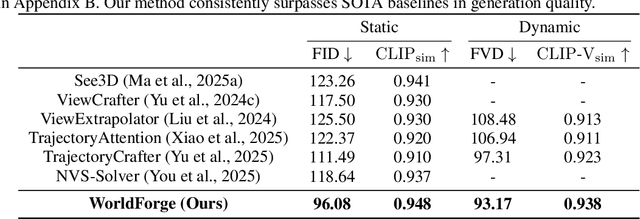
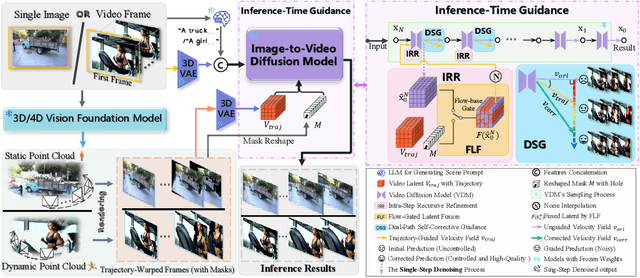
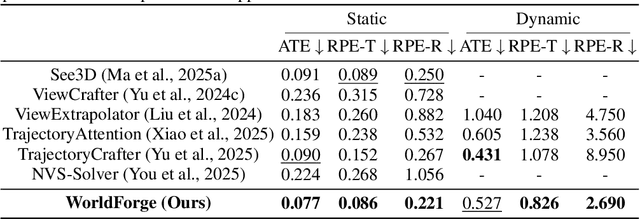
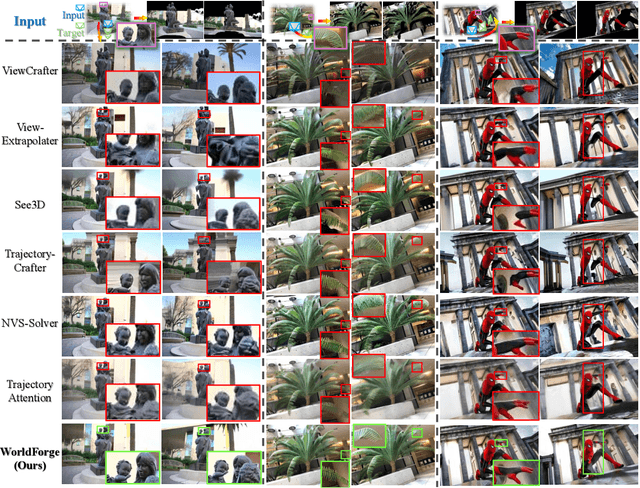
Recent video diffusion models demonstrate strong potential in spatial intelligence tasks due to their rich latent world priors. However, this potential is hindered by their limited controllability and geometric inconsistency, creating a gap between their strong priors and their practical use in 3D/4D tasks. As a result, current approaches often rely on retraining or fine-tuning, which risks degrading pretrained knowledge and incurs high computational costs. To address this, we propose WorldForge, a training-free, inference-time framework composed of three tightly coupled modules. Intra-Step Recursive Refinement introduces a recursive refinement mechanism during inference, which repeatedly optimizes network predictions within each denoising step to enable precise trajectory injection. Flow-Gated Latent Fusion leverages optical flow similarity to decouple motion from appearance in the latent space and selectively inject trajectory guidance into motion-related channels. Dual-Path Self-Corrective Guidance compares guided and unguided denoising paths to adaptively correct trajectory drift caused by noisy or misaligned structural signals. Together, these components inject fine-grained, trajectory-aligned guidance without training, achieving both accurate motion control and photorealistic content generation. Extensive experiments across diverse benchmarks validate our method's superiority in realism, trajectory consistency, and visual fidelity. This work introduces a novel plug-and-play paradigm for controllable video synthesis, offering a new perspective on leveraging generative priors for spatial intelligence.
 Add to Chrome
Add to Chrome Add to Firefox
Add to Firefox Add to Edge
Add to Edge